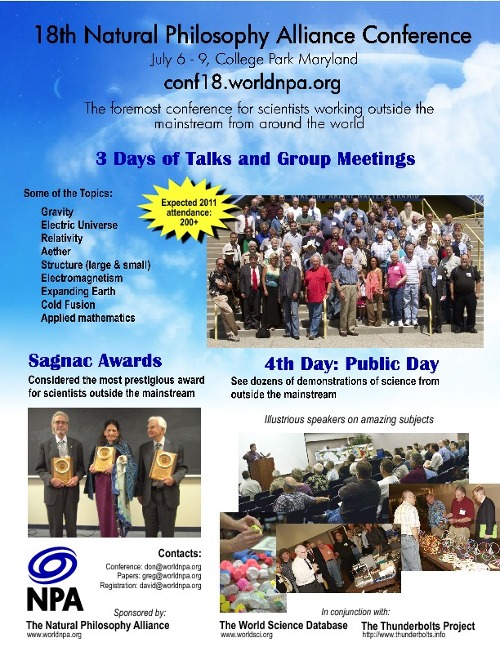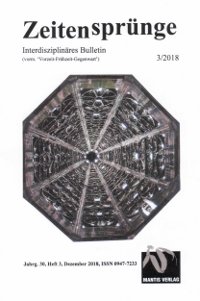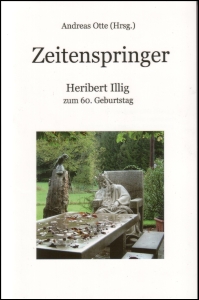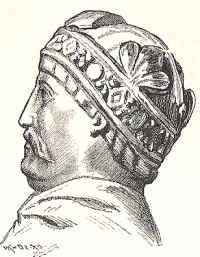Die Natural Philosophy Alliance hält ihre diesjährige Konferenz vom 6. – 9. Juli 2011 an der Universität von Maryland ab, College Park, USA. Wofür die Natural Philosophy Alliance steht, beschreibt am besten der folgende Text mit dem Titel “Our Minimum Consensus“:
In science, it is all too easy to jump to conclusions. As the development during the past century has shown, this seems particularly true of physics. Scientific modeling should and must be consistent and free of internal contradictions. This begins with the very first step: Analyze the vocabulary used in order to define the problem in question. Many a discussion is bound to remain fruitless if there is no consensus even about the basic terminology. For instance, ’relative velocity’ may have different meanings, depending on the view of velocity. The interpretation “two bodies are in relative motion if their mutual distance changes with time” does not respect the vector property of velocities. It is often easily overlooked ‘trifles’ like this that make consensus impossible. Likewise, ‘time’ and ‘space’ provide unexpected pitfalls if unspecified. ‘Time’ is not identical with ‘duration’ and ‘space’ is not ‘volume’. Time and space in their abstract general physical meaning provide the stage on which events happen. Hence they are not subject to the events themselves. Scientific language must be unique.
A major difference between physics and math is that pure numbers don’t give us physics. The dimensions of physical quantities must be respected, independent of the system of units chosen. This is a necessary, not sufficient, condition to formulate physical ideas correctly. We should have consensus about the use of mathematics in physics as an assistant science. Math is a wonderful and most valuable help in physics – if used properly; it is a catastrophe if allowed to enslave physical ideas as is the case in certain (you-know-which) 20th century cult theories. These cult theories blocked the progress of physics more than anything else and we should consider it our task to tell the public why they should be abandoned in spite of their pseudo-successes (with math, it is possible to make a physically untenable theory yield numerically correct results, just think of cosmology before Kepler). To rid physics of this burden is not only a matter of saving uncounted $$ spent by the taxpayer and wasted by the ‘science lords’ for fruitless research that serves only their (the lords’) purpose. This is also a matter of putting physics back on the track where it once was a real science, just think of the great achievements of the 17th to 19th centuries. Their progress in science deserves to be continued in all modesty. Do not “reach for the stars”. Looking for a world formula is like looking for the pot of gold at the end of the rainbow. Nature’s Giant Puzzle is impossible to solve completely. We are lucky if a few pieces fit. […] (Peter Marquardt, Köln)
Die Konferenz ist für Vertreter der Theorie vom Elektrischen Universum besonders interessant, da die Gruppe mit ca. 10 Vortragenden vertreten sein wird. Das wird über 4 Tage neben interessanten Vorträgen und Vorführungen auch Raum für viele informative Gespräche bieten. Der Flyer zur Konferenz findet sich hier.
Konferenzteilnehmer (Eine kleine Auswahl): Dr. Halton C. Arp, Prof. Andre K. T. Assis, Dwardu Cardona, Ev Cochrane, Dr. C. J. Ransom, Ralph N. Sansbury, Prof. Donald E. Scott, David Talbott, Wallace Thornhill, Rens Van der Sluijs.
Vorträge des Thunderbolts Project:
Wal Thornhill:
“The Natural Philosophy of the Electric Universe” (The John Chappell Memorial Lecture)
“Galaxies and Stars in an Electric Universe”
David Talbott:
“Electric Universe: An Interdisciplinary Perspective”
“Electric Universe: The Planets Bear Witness”
Jim Johnson:
“Essential Guide to the Electric Universe”
Michael Gmirkin:
“The Sun-Earth Connection”
Dwardu Cardona:
“Earth’s Primeval Polar Heat”
Ev Cochrane:
“Evidence for a Radically Different Solar System in Recent History”
Bob Johnson:
“Exploring Galactic and Heliospheric Electric Currents”
Tom Findlay:
“Introductory Guide to the Electric Universe”
Rens van der Sluijs:
“Towards a History of Plasma-Universe Theory”
Tim Erney:
“The Drift-Alfvén Model for a Magnetized Plasma Applied to Saturn’s Polar Vortices”
Michael Steinbacher, Mel Acheson:
“A New Approach to Mountain Formation”





